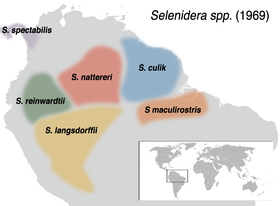Short-billed toucans
| Short-billed toucans | ||||||||
|---|---|---|---|---|---|---|---|---|

Peppereater , illustration by John Gould. The male sits below, the female above. |
||||||||
| Systematics | ||||||||
|
||||||||
| Scientific name | ||||||||
| Selenidera | ||||||||
| Gould , 1837 |
The short-beaked toucans ( Selenidera ), also called short-billed macaws, are a genus from the toucan family. The genus contains six species. Five of them occur in South America, the distribution area of the sixth kind extends to Central America. In contrast to the other toucan species, short-billed macaws show a conspicuous sexual dimorphism .
Appearance
All species have a green to green-olive upper body and red under-tail-covers. The featherless region around the eye is bluish to bluish green. The males all have a black head and neck, and a black throat and chest. The ear cover is yellow. The females have a brown head and neck in most species. Apart from the Gelbohrarassari, all species have a striking neck band and tail feathers with brown tips. The tail is tiered and short in relation to body size.
They are relatively small toucans; they reach body lengths between 30 and 35 centimeters. The largest type is the Gelbohrarassari, which reaches a body length of 35 to 40 centimeters and a weight of 200 to 270 grams. The beak of all species is long and strong in relation to body size. In the male Gelbohrarassari, for example, it reaches a length of 8.3 to 10.2 centimeters. Females correspond in body dimensions to the males, but their beak is a little shorter. Females of the Gelbohrarassaris have a beak length between 7.6 and 9.2 centimeters.
Distribution area, habitat and way of life
The range of the short-billed toucans stretches from northern Honduras to the southeast of Brazil. The respective distribution areas are adjacent to one another. The Gelbohrarassari is the only species of the genus that also occurs west of the Andes.
Short-billed macaws are preferred in forest areas of the lowlands, where they are mainly in the upper tree regions. As with all toucans, fruits play a major role in the diet, but they also eat insects and bird eggs are also recorded in the food spectrum for individual species. As a rule, very little is known about reproductive biology. The only species occasionally kept in European zoos and bird parks is the pepper eater .
Research history

The short-billed toucans served the German natural scientist Jürgen Haffer as an example for his hypothesis on the development of species. In his opinion, the recent species of short-billed toucans descend from a species whose range was fragmented when the rainforests shrank in the drier periods of the Pleistocene and were only found in the wetter regions. The individual species developed in these isolated distribution areas. The expansion of the rainforests in the more humid periods of the Pleistocene resulted in the areas of distribution of the individual species becoming larger again and today, in places, border one another.
Haffer's hypothesis is not undisputed. The main criticism is that there is little empirical data to support this. However, it is considered a possible explanation for the biodiversity of South America. The theory is supported by the fact that the respective distribution areas each have a river system as their center. The species are also grouped into a superspecies . The yellow-billed carassari, which has several characteristics not found in other short-billed carassari, may have been isolated from the other species very early.
species
The following species are counted among the short-billed macaws:
- Yellow-eared Macarassari ( S. spectabilis )
- Natterer-Arassari ( S. nattereri )
- Pepper eater ( S. culik )
- Spotted arassari ( S. maculirostris )
- Gould Arassari ( S. gouldii )
- Reinwardt-Arassari ( S. reinwardtii )
supporting documents
literature
- Jürgen Haffer: Speciation in Amazonian Forest Birds. In: Science. Volume 165, 1969, pp. 131-137
- Werner Lantermann: Toucans and Arassaris. Filander Verlag, Fürth 2002, ISBN 3-930831-46-5 .
- Lester L. Short, Jennifer FM Horne: Toucans, Barbets and Honeyguides - Ramphastidae, Capitonidae and Indicatoridae. Oxford University Press, Oxford 2001, ISBN 0-19-854666-1 .